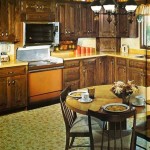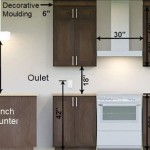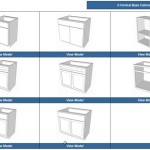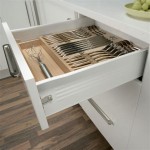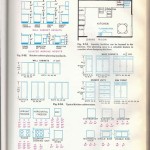Slab Front Kitchen Cabinets: A Modern and Minimalist Design Choice
Slab front kitchen cabinets, characterized by their flat, unadorned doors and drawer fronts, represent a significant departure from more traditional cabinet styles. This design emphasizes clean lines, simplicity, and a minimalist aesthetic. They have gained significant popularity in recent years due to their adaptability to various kitchen designs and their ability to create a sleek, contemporary feel. Understanding the characteristics, benefits, and considerations surrounding slab front cabinets is crucial for homeowners and designers seeking to incorporate this style into their projects.
This article will explore the defining features of slab front cabinets, delve into the reasons for their growing popularity, discuss the variety of materials and finishes available, and provide insights on how to effectively integrate them into a kitchen design to achieve a cohesive and visually appealing space. It will also address potential drawbacks and provide guidance on proper maintenance to ensure longevity and enduring aesthetic appeal.
Defining Characteristics of Slab Front Cabinets
The most distinguishing feature of slab front cabinets is their flat, single-piece construction. Unlike shaker or raised-panel cabinets, which feature frames, panels, and decorative elements, slab front cabinets are made from a single, unbroken surface. This minimalist construction leads to several advantageous properties:
Simplicity of Design: The absence of ornamentation allows the materials and finishes to take center stage. The focus shifts from intricate detailing to the inherent beauty and texture of the chosen material, whether it be wood, laminate, or metal. This inherent simplicity allows the cabinets to seamlessly blend with a variety of design styles, from ultra-modern to Scandinavian-inspired.
Clean Lines and Uncluttered Appearance: The flat surfaces create a sense of visual order and spaciousness. This is particularly beneficial in smaller kitchens where minimizing visual clutter is paramount. The clean lines contribute to a more airy and open feel, preventing the space from feeling cramped or overwhelming.
Ease of Cleaning: The smooth, unbroken surfaces of slab front cabinets are exceptionally easy to clean. There are no grooves, crevices, or intricate details where dirt and grime can accumulate. A simple wipe-down with a damp cloth is typically sufficient to maintain their pristine appearance. This ease of maintenance is a significant advantage for busy homeowners.
Modern and Contemporary Aesthetic: Slab front cabinets are inherently aligned with modern and contemporary design principles. Their minimalist form reflects a focus on functionality and simplicity, characteristics that are highly valued in these styles. They are a natural fit for kitchens that embrace clean lines, geometric shapes, and a lack of ornamentation.
Advantages of Choosing Slab Front Cabinets
The increasing popularity of slab front cabinets is driven by a multitude of benefits that extend beyond their visual appeal. They offer practical advantages in terms of cost-effectiveness, versatility, and ease of customization.
Cost-Effectiveness: The simplified construction of slab front cabinets often translates to lower manufacturing costs compared to more elaborate cabinet styles. The absence of intricate joinery and decorative elements reduces the labor and material requirements, making them a more budget-friendly option for many homeowners. This cost advantage can be especially significant when renovating an entire kitchen.
Versatility in Design: Slab front cabinets are remarkably versatile and can be adapted to a wide range of kitchen design styles. While they are most commonly associated with modern and contemporary aesthetics, they can also be incorporated into transitional, Scandinavian, and even minimalist farmhouse designs. The key lies in the choice of materials, finishes, and hardware.
Customization Options: Despite their minimalist appearance, slab front cabinets offer a wide range of customization options. Homeowners can choose from a variety of materials, including solid wood, wood veneer, laminate, thermofoil, and metal. They can also select from a vast array of colors, textures, and finishes to create a truly unique and personalized kitchen space. The choice of hardware, such as pulls and knobs, also plays a significant role in defining the overall aesthetic.
Space Optimization: The clean lines and uncluttered surfaces of slab front cabinets contribute to a more spacious and organized feel, which is especially beneficial in smaller kitchens. They can also be effectively utilized in open-concept kitchens to create a seamless transition between the kitchen and living areas. The minimalist design helps to prevent the kitchen from visually dominating the space.
Materials and Finishes for Slab Front Cabinets
The selection of materials and finishes is crucial in determining the overall look and feel of slab front cabinets. The choices are vast, ranging from natural wood to durable laminates, each offering unique aesthetic and performance characteristics.
Solid Wood: Solid wood cabinets offer a timeless and luxurious appeal. They are durable, long-lasting, and can be refinished multiple times. Popular wood species for slab front cabinets include maple, oak, cherry, and walnut. The natural grain patterns and variations in color add warmth and character to the kitchen. However, solid wood cabinets are typically more expensive and require careful maintenance to prevent warping and cracking.
Wood Veneer: Wood veneer cabinets consist of a thin layer of natural wood applied to a substrate, such as plywood or MDF. This option offers the aesthetic appeal of solid wood at a lower cost. Wood veneer cabinets are also less susceptible to warping and cracking than solid wood. However, they are not as durable as solid wood and cannot be refinished as many times.
Laminate: Laminate cabinets are made from layers of paper or fabric impregnated with resin and bonded to a substrate. They are a cost-effective and durable option that is available in a wide range of colors, patterns, and textures. Laminate cabinets are resistant to scratches, stains, and moisture, making them a practical choice for busy kitchens. They are also easy to clean and maintain.
Thermofoil: Thermofoil cabinets are made from MDF covered with a thin layer of vinyl film. They are a cost-effective and durable option that is available in a variety of colors and finishes, including solid colors, wood grains, and textured surfaces. Thermofoil cabinets are resistant to moisture and are easy to clean. However, they are not as heat-resistant as other materials and can be damaged by excessive heat.
Metal: Metal cabinets offer a sleek and modern aesthetic. They are durable, easy to clean, and resistant to moisture and stains. Metal cabinets are typically made from stainless steel or aluminum. They are often used in commercial kitchens but are also gaining popularity in residential kitchens. Metal cabinets can be expensive but offer a unique and contemporary look.
The finish applied to the slab front cabinets greatly impacts its final appearance and durability. Popular finishes include paint, stain, lacquer, and varnish. Paint offers a wide range of color options and can be used to create a smooth, even finish. Stain allows the natural grain of the wood to show through and provides a warm, rich look. Lacquer and varnish provide a durable, protective coating that enhances the beauty of the wood.
The choice of edge banding for the slab fronts is another crucial detail. Edge banding conceals the raw edges of the core material (like MDF or particleboard) and provides a finished look. Options range from matching wood veneer or laminate to contrasting materials like metal or acrylic, creating a visually interesting accent.
Integrating Slab Front Cabinets into Kitchen Design
Successfully incorporating slab front cabinets into a kitchen design requires careful consideration of layout, color scheme, hardware, and overall style. The minimalist nature of these cabinets allows for a high degree of flexibility, but it is essential to maintain a cohesive and balanced aesthetic.
Layout Considerations: Slab front cabinets work well in both small and large kitchens. In smaller spaces, their clean lines and uncluttered surfaces can create a sense of spaciousness. In larger kitchens, they can be used to create a sleek and modern look. Consider the overall layout of the kitchen and the placement of appliances when designing with slab front cabinets.
Color Scheme: The color scheme of the kitchen should complement the style of the slab front cabinets. Neutral colors, such as white, gray, and beige, are popular choices for modern and contemporary kitchens. Bold colors, such as blue, green, and red, can be used to create a more dramatic look. The choice of countertop material and backsplash tile should also be carefully considered to create a harmonious color palette.
Hardware Selection: The hardware chosen for slab front cabinets can significantly impact their overall aesthetic. Minimalist pulls and knobs are a popular choice for modern kitchens. Sleek, stainless steel hardware complements the clean lines of the cabinets. Alternatively, textured or decorative hardware can be used to add visual interest and personality. Consider the size and shape of the hardware in relation to the size and shape of the cabinet doors and drawers.
Style Integration: While slab front cabinets are most commonly associated with modern and contemporary styles, they can also be incorporated into other design schemes. In transitional kitchens, they can be paired with traditional elements, such as decorative moldings and ornate hardware. In Scandinavian kitchens, they can be combined with natural materials, such as wood and stone. In minimalist farmhouse kitchens, they can be paired with rustic accents, such as shiplap walls and exposed beams.
Lighting Design: Proper lighting is essential for highlighting the beauty of slab front cabinets. Under-cabinet lighting can illuminate countertops and backsplashes, while recessed lighting can provide overall ambient lighting. Pendant lights can be used to add visual interest and create a focal point. The type and placement of lighting should be carefully considered to enhance the functionality and aesthetics of the kitchen.
The integration of handleless designs is a significant trend within slab front cabinetry. Push-to-open mechanisms or integrated finger pulls offer an even more minimalist and seamless look, further enhancing the clean lines of the cabinets. These designs require precise installation and high-quality hardware to ensure reliable operation. Another trend is incorporating integrated lighting within the cabinet interiors, which not only provides functional illumination but also adds a touch of modern sophistication.
In conclusion, slab front kitchen cabinets represent a versatile and visually appealing choice for homeowners seeking a modern and minimalist aesthetic. Their clean lines, cost-effectiveness, and extensive customization options make them a popular choice for a wide range of kitchen designs. Careful consideration of materials, finishes, hardware, and layout are crucial for successfully integrating slab front cabinets into a cohesive and functional kitchen space.

Kitchen Cabinet Door Styles Cabinets Of The Desert

7 Slab Kitchen Cabinet Ideas That Go Beyond Modern Semistories

Timeless Slab Door Style For Every Kitchen

Four Reasons To Choose Slab Doors Gem Cabinets

Slab Style Cabinetry Offers Flexibility And Value

Natural Wood Slab Cabinet Fronts The Face

Blond Flat Front Kitchen Cabinets With Quartz Slab Backsplash Modern

Slab Style Cabinetry Offers Flexibility And Value

Why Slab Door Cabinets May Be Falling Out Of Style In 2024

The 411 On Kitchen Cabinet Door Designs Sweeten Blog
Related Posts

